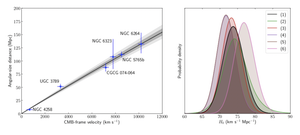Megamaser Cosmology: A Better Hubble Constant
 The authors present a measurement of the Hubble constant made using geometric distance measurements to megamaser-hosting galaxies. They have applied an improved approach for fitting maser data and obtained better distance estimates for four galaxies previously published by the Megamaser Cosmology Project: UGC 3789, NGC 6264, NGC 6323, and NGC 5765b. Combining these updated distance measurements with those for the maser galaxies CGCG 074-064 and NGC 4258, and assuming a fixed velocity uncertainty of 250 km s−1 associated with peculiar motions, this work constrains the Hubble constant to be H0 = 73.9 ± 3.0 km s−1 Mpc−1 independent of distance ladders and the cosmic microwave background. This best value relies solely on maser-based distance and velocity measurements, and it does not use any peculiar velocity corrections. Different approaches for correcting peculiar velocities do not modify H0 by more than ±1σ, with the full range of best-fit Hubble constant values spanning 71.8 – 76.9 km s−1 Mpc−1. The authors corroborate prior indications that the local value of H0 exceeds the early-Universe value, with a confidence level varying from 95% to 99% for different treatments of the peculiar velocities.
The authors present a measurement of the Hubble constant made using geometric distance measurements to megamaser-hosting galaxies. They have applied an improved approach for fitting maser data and obtained better distance estimates for four galaxies previously published by the Megamaser Cosmology Project: UGC 3789, NGC 6264, NGC 6323, and NGC 5765b. Combining these updated distance measurements with those for the maser galaxies CGCG 074-064 and NGC 4258, and assuming a fixed velocity uncertainty of 250 km s−1 associated with peculiar motions, this work constrains the Hubble constant to be H0 = 73.9 ± 3.0 km s−1 Mpc−1 independent of distance ladders and the cosmic microwave background. This best value relies solely on maser-based distance and velocity measurements, and it does not use any peculiar velocity corrections. Different approaches for correcting peculiar velocities do not modify H0 by more than ±1σ, with the full range of best-fit Hubble constant values spanning 71.8 – 76.9 km s−1 Mpc−1. The authors corroborate prior indications that the local value of H0 exceeds the early-Universe value, with a confidence level varying from 95% to 99% for different treatments of the peculiar velocities.
Figure caption: [Left] Distance to the megamaser galaxies. [Right] Probability distribution for H0 for the six galaxies.
Publication: D.W. Pesce (Harvard-Smithsonian Center for Astrophysics) et al., The Megamaser Cosmology Project. XIII. Combined Hubble Constant Constraints, Astrophysical Journal Letters, 891, L1 (1 March 2020).
NRAO Press Release: New Distance Measurements Bolster Challenge to Basic Model of Universe




Connect with NRAO